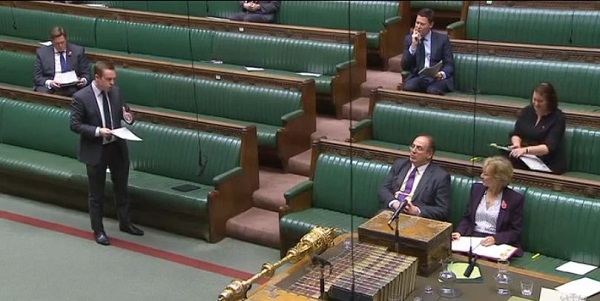
Fitness industry should be supporting squash
By JOEL DURSTON – Squash Mad Special Correspondent
Squash received a much needed boost last week as Conservative MP for Corby and East Northamptonshire Tom Pursglove raised the issue in the House of Commons of Corby having no squash courts.
He had recently attended a World Squash Day event at the squash courts at Uppingham School Sports Centre, where he had seen the mental, physical and social benefits of squash.
He told the House: “The weekend before last, I attended a brilliantly organised World Squash Day event, organised by my constituent James Roberts, but frustratingly we do not have any squash courts in Corby.
“May we have a debate to discuss the benefits of squash and the pressing need for squash courts in Corby.”

For a town with a population of over 65,000, it’s a sad state of affairs to have no squash court. And, while it is a stark example, the biggest UK town with no courts, it illustrates a wider trend of the shortage of squash courts across many areas of England (and the UK), an issue over which squash fans are joining with Mr Pursglove to call for a debate on squash in Parliament.
According to Sport England figures 199,500 people in England play squash and racketball every week and there is a total of about 4,200 courts, meaning there are 47 and a half regular players to each court. And many of these courts are in private clubs, making it harder to attract new players.
This compares badly with the most similar sports to squash, tennis and badminton. Tennis has 398,100 regular players and 21,186 courts, and badminton has 425,800 regular players and around 20,000 courts, meaning they have respectively 19 and 21 players per court.
The figures become even more stark when you consider that tennis and badminton can be played in doubles format, so there are more people to every court (squash can be played as doubles, but typically only in a much more informal way on a singles court). Indeed, competitive team tennis and badminton are typically played in doubles format.
The relative shortage of squash courts is particularly strange given the rude health of the fitness industry. The 2017 State of the UK Fitness Industry Report reveals there are now 9.7 million fitness members in the UK. In other words, one in seven people in the UK is a member of a gym, following big year-on-year increases in the number of fitness facilities (4.6%), members (5.1%) and market value (6.3%).
Surely an activity which has been ranked as the toughest sport by Forbes, a mano e mano battle of agility, creativity and mentality, is more appealing than doing some weights or effectively running on the spot on a treadmill?! And at around 40/45 minutes for a full game, it fits perfectly with busy lives.
With a market value of £4.7 billion, could the fitness industry not use some of those pounds and pennies on some courts?
Maybe it’s largely a chicken-and-egg problem; courts are in short supply so people stop playing and friends and family are not introduced to the game, and, over time, people stop playing so regularly (or at all), so courts are closed.
Another problem squash is up against is its lack of visibility, most notably its baffling exclusion from the Olympic Games. This is not mere bias; many is the time I’ve told a friend squash is not in the Olympics and they have been very surprised it is not and asked the reason why.
And it is just the kind of sport without much mainstream coverage that would likely benefit hugely from Olympic inclusion.
For example, badminton gained around 35,000 new adult players during 2012 , following the home Olympic Games that summer, according to Sport England figures which showed adults playing sport at least once a week increased by 750,000 during the same period.
So merely claiming ‘the interest isn’t there’ is self-defeating and gets the cause and effect of the situation all wrong.
As in Field of Dreams, the 1989 film about the lowly farmer who, against all the odds, dreams of building a brilliant baseball ground on his land, build it and they will come…
COMMENT: Readers are invited to comment below.
Pictures from Squash Mad archive
